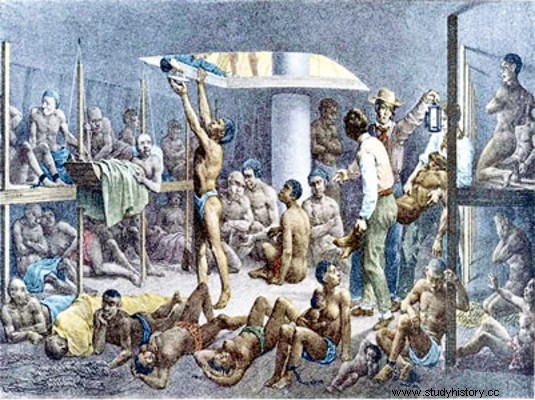
By Tales Pinto
The Male Revolt occurred on January 25, 1835 , in Salvador – Bahia, was part of the series of revolts that endangered the Brazilian imperial state during the Regency Period (1831-1840). Not so much for its duration, but for its composition and threat to the slave society.
The Malê Revolt was a revolt organized and led by Africans, enslaved or free, whose objective was the abolition of slavery and the Africanization of Bahia. The revolt raised fear again among the Brazilian slave-owning exploiting class of the repetition of the Haitian Revolution on national soil, which exterminated and expelled almost the entire white population from the island of the Antilles.
Another peculiar characteristic of the Malê Revolt was the fact that the slaves who participated in it were mostly Muslims. Male was the name given to every slave , of any ethnicity, who professed the Muslim religion and knew how to read and write in Arabic. In addition, most of the participants, thanks to these attributions, mainly fulfilled the function of gain slaves, destined to perform paid urban services, obtaining money for their masters.
It is interesting to read an extract from the account given by the police chief of Salvador, Francisco Gonçalves Martins, published in the Jornal do Commercio , from Rio de Janeiro, on February 10, 1835:
“the insurrection had been plotted for a long time, with an inviolable secret, and under a higher plane than we should have expected from its brutality and ignorance. In general, almost all of them know how to read and write in unknown characters, which are similar to the Arabic, used among the Ussás, who today have combined with the Nagós. That Nation in another time was the one that rose up in this Province several times, being later replaced by the Nagós. There are masters who give lessons, and who stop organizing the insurrection, in which many African ceilings, and even rivers, hinder.”
“Many books have been found, some of which are said to be religious precepts, taken from mixtures of sects, mainly from the Quran. It is certain that Religion had its part in the uprising, and the leaders persuaded the wretched that certain papers would deliver them from death, whence a great part of the rights are found in dead bodies, and in rich and exquisite clothing, that big shots belong to the chiefs, and that will be found in some searches.”¹
The chief of police points out the fact that blacks are mainly from the Nagô and Ussás (or Hausa) nations and with a unity built between them as a result of religion and literacy. These Africans also organized other revolts in the province, which shows that the Malê Revolt was one among other slave revolts.
The revolt had been organized in advance and still had the participation of freed blacks, those who had received their manumission. The fact that the police chief indicated that religion played a part in the uprising and that participation could save them from death may indicate that the Malê Revolt was also a case of jihad , the holy war against non-Muslims.
Even with the organization carried out in advance, the revolt was not successful. The forecast was the attack on government buildings, mainly buildings occupied by police and military forces. The date was chosen because there is a Catholic feast, that of Nossa Senhora da Guia, and also because it is the day of the Qadr , the day of Koranic revelation². The objective was to carry out the assault on the buildings at dawn on the 25th of January. However, a complaint made to the police forces, possibly by two freed slaves who learned of the action the day before, led to the fallout of the attack.
A house where about 60 slaves used to meet was raided by the police. The Africans, threatened with being caught, started to confront the police forces armed with swords and machetes, as well as few firearms. During the dawn and the following day, the capital of the province of Bahia was besieged by the insurgents. However, the cavalry and more troops that came in reinforcements managed to contain the revolt. Some managed to escape through the Recôncavo, attacking the cane fields, but they were also contained in these spaces.
An estimated 600 to 1500 Africans participated in the uprising. Dozens were killed and many were arrested, punished and deported. Torture and scourging made up the forms of punishment, especially for freedmen, since slaves still had productive functions to fulfill.
Contrary to other colonial and Imperial period rebellions, the Mal ê Revolt was composed exclusively by Africans, without the direction of whites. This fact provided the great impact and fear in the free Bahian and Brazilian population of the period. An anonymous commentator who witnessed the rebellion, in the newspaper Pão D’Assucar , published in Rio de Janeiro, on 02/10/1835, illustrated with his words the apprehension of part of the population of the Empire:“Now evaluate here the risk we run with such people, and what we may still suffer one day, if not always exercise the strictest caution”³.
––––––––––––––––
* Image Credit:New York Public Library Digital Gallery.
[1] CAIRUS, José Antonio Teófilo. Jihad , Captivity and Redemption:Slavery, Resistance and Brotherhood, Central Sudan and Bahia (1835). Masters dissertation. Rio de Janeiro:UFRJ, 2002. p. 26. Can be found at:Casadasafricas.org .
² Idem. Ibid. . P. 14.
³ Idem. Ibid. . P. 29.
